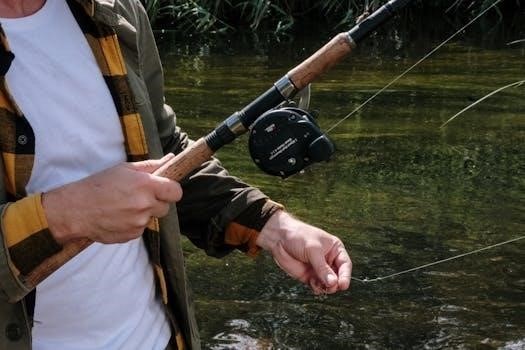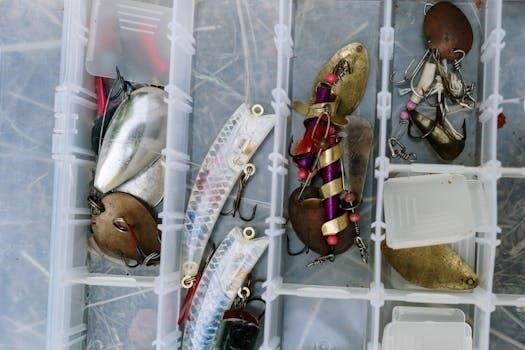Understanding Fishing Rod Guide Size Charts
Fishing rod guide size charts are fundamental tools for anglers. These charts provide specific measurements, essential for optimal rod performance. They ensure proper line flow, maximizing casting distance. Additionally, they contribute to balanced rod dynamics.
Importance of Guide Spacing
Proper guide spacing is crucial for a fishing rod’s overall performance, impacting casting distance, accuracy, and sensitivity. When guides are correctly spaced, the fishing line flows smoothly along the rod blank, minimizing friction and maximizing casting distance.
In contrast, poorly spaced guides can create friction points, hindering the line’s travel and reducing casting efficiency. Incorrect spacing may also cause uneven stress distribution along the rod, leading to potential damage or breakage.
Furthermore, appropriate guide spacing is essential for sensitivity. Well-placed guides transmit vibrations from the line to the angler’s hand, allowing for better detection of subtle strikes. Therefore, paying close attention to guide spacing is vital for optimal fishing experience.
Impact on Casting Performance
The arrangement of guides on a fishing rod significantly affects casting performance. Proper guide spacing optimizes line flow during a cast, reducing friction and maximizing distance. When the line travels smoothly through the guides, it allows the rod to load and unload efficiently.
Conversely, improperly spaced guides can impede the line’s path. This creates drag and reduces casting distance. Moreover, incorrect guide placement can cause the line to slap against the rod blank. This wastes energy and diminishes accuracy.
Therefore, careful consideration of guide spacing is crucial for achieving optimal casting performance. Using guide spacing charts can ensure proper placement. Ultimately, this leads to longer, more accurate casts. This enhances the overall fishing experience.
Rod Balance Considerations
Guide placement also plays a vital role in the overall balance of a fishing rod. A well-balanced rod feels lighter in hand and reduces fatigue during long fishing sessions. The distribution of weight along the rod affects its sensitivity and responsiveness.
Incorrect guide placement can create an imbalance, making the rod feel tip-heavy or butt-heavy. This can negatively impact casting accuracy and the ability to detect subtle strikes. Adjusting guide sizes and positions can fine-tune the rod’s balance.
Experimentation and personal preference are key factors in achieving optimal rod balance. Some anglers prefer a slightly tip-heavy rod for improved casting distance. Others prefer a balanced rod for enhanced sensitivity. Ultimately, the goal is to create a rod that feels comfortable and performs well.

Components of a Fishing Rod Guide Size Chart
Guide spacing charts typically incorporate several key components. These include rod length, line weight recommendations, and fishing type. Understanding these elements allows for correct guide selection and placement for optimal performance.
Rod Length
Rod length is a primary factor when consulting guide spacing charts. The overall length of the rod blank directly influences the placement and number of guides required. Longer rods typically necessitate more guides, spaced strategically to manage line control and prevent excessive sagging between guides. Conversely, shorter rods may require fewer guides, focusing on maintaining line flow during the cast and retrieve.
Accurate measurement of the rod blank is crucial for utilizing guide spacing charts effectively. Charts often provide measurements from the tip of the rod.
Consider that the specific action of the rod, that is, how much the rod bends under pressure, also interacts with the length to determine guide placement, ensuring optimal energy transfer and casting performance. The ultimate goal is to have the rod perform at its peak.
Line Weight
Line weight plays a crucial role in selecting appropriate guide sizes and spacing. Heavier lines generate more friction as they pass through the guides. This necessitates larger guides, particularly the stripping guide, to reduce friction. Consequently, this maintains casting distance and prevents premature line wear. Lighter lines require smaller guides, minimizing weight and drag.
Guide spacing charts often specify different configurations based on the intended line weight for the rod. Using the wrong guide size for the line weight can negatively impact casting performance. It can also reduce sensitivity, and potentially damage the line.
Careful consideration of the line weight, alongside rod length and fishing type, is essential for proper guide selection and placement. Following guide spacing charts ensures that the rod is optimized for the intended fishing application. It will result in better casting, increased sensitivity, and longer line life.
Fishing Type (Spinning, Casting, Fly)
The type of fishing significantly influences guide selection and spacing. Spinning rods typically use smaller, more numerous guides to control the line’s coils as it comes off the spinning reel. Casting rods, on the other hand, use larger, fewer guides to accommodate the line’s straighter path from the casting reel.
Fly rods have unique guide systems, often with snake guides, designed for the specific needs of fly fishing. Guide spacing charts often have different recommendations depending on whether you are building a spinning, casting, or fly rod.
The type of fishing impacts the forces exerted on the rod and line, influencing guide placement. Using a guide chart tailored to the fishing type ensures the rod performs optimally. It will properly manages line flow, maximizes casting distance, and provides the desired action for the intended species and techniques.

Utilizing Guide Spacing Charts
Effectively using guide spacing charts is vital for custom rod building. These charts provide precise measurements to optimize guide placement. Anglers must follow them carefully to enhance casting performance.
Finding Brand-Specific Charts
Locating brand-specific guide spacing charts is crucial for achieving optimal performance with your fishing rod. Many rod building parts companies, like Mudhole and Angler’s Workshop, offer these charts tailored to their products. These charts provide precise measurements for guide placement based on the specific blank design and intended fishing style.
Manufacturers such as MHX and Rainshadow also provide suggested guide spacing charts, which can be found on their websites or through authorized dealers. These charts are often organized by rod type, including spinning, casting, fly, musky, saltwater, and salmon/steelhead rods. Brand-specific charts consider the unique characteristics of their blanks, ensuring proper guide alignment.
Furthermore, some brands, like Tom Morgan Rodsmiths, offer detailed guide spacing and size charts that have been carefully worked out for their designs. These charts may seem unconventional, but they are based on years of experience and testing to optimize rod performance. By using brand-specific charts, you can be confident that your guide spacing is tailored to the specific rod blank you are using.
Adjusting for Personal Preferences
While guide spacing charts provide a solid starting point, adjusting for personal preferences is essential for optimizing your fishing rod’s performance to your specific needs. Many anglers develop their own preferences for guide size and spacing based on their casting style and the types of fish they target. Consider adjusting the guide spacing based on the length of your handle, the type of guides you are using, and their sizes.
Experiment with different guide placements to find what works best for you, keeping in mind that poorly spaced guides can apply odd angular forces, which can reduce the rod’s power. Adjustments might involve moving guides slightly closer or further apart to fine-tune the line flow and casting distance.
If you’re using longer fly rods, consider using two stripping guides to better manage the line. Remember that the suggested spacings are just starting points, and you should feel free to deviate from them if you have different ideas. Ultimately, the best guide spacing is the one that feels right for you and enhances your fishing experience.

Resources for Guide Spacing Charts
Numerous resources exist for accessing guide spacing charts. Online calculators, like those once offered by PacBay, are helpful. Rod building parts companies, such as Mudhole, provide comprehensive charts.
Online Calculators
Online calculators represent a valuable resource for determining guide spacing. These tools often incorporate various factors, including rod length and line weight. Some calculators may also account for fishing style preferences. Historically, companies like PacBay offered such calculators, aiding rod builders.
These calculators typically require users to input specific rod parameters. Based on this data, the calculator generates a suggested guide spacing configuration. This can be a useful starting point for custom rod builds. However, it’s crucial to remember that these are just suggestions.
Anglers can adjust these recommendations based on personal preferences and experience. While some online calculators may no longer be actively maintained, archived versions might still exist. Furthermore, newer calculators may have emerged from other rod building communities. Therefore, exploring available online options can significantly aid in the guide spacing process, providing a calculated baseline for customization. Always double-check the results.
Rod Building Parts Companies
Rod building parts companies serve as primary resources. They provide charts detailing appropriate guide placement, crucial for custom rods. These companies often offer a range of charts, categorized by rod length. This simplifies selecting the correct spacing for specific rod builds.
Companies like Mudhole and Anglers Workshop typically include these charts. They often consider rod length, blank material and intended use. The charts assist builders in achieving optimal performance and balance. Furthermore, these companies may offer expert advice and support.
By consulting these charts, builders can avoid common spacing errors. This contributes to enhanced casting distance and sensitivity. These charts consider factors like guide size and type. Ultimately, rod building parts companies provide essential resources. They ensure that rod builders have access to accurate guide spacing information. This facilitates the creation of high-quality, custom-built fishing rods and improves the fishing experience.

General Guide Spacing Suggestions
General guide spacing suggestions provide a starting point for rod builders. These suggestions offer approximate measurements for guide placement on a rod blank. They can be adapted to fit individual needs and preferences during the build. These are not definitive but good guidelines.
Consider the rod’s length and intended application when evaluating suggestions. Shorter rods need closer guide spacing, usually towards the tip. Longer rods usually require a progressive increase in guide spacing from tip to base. Factors like line weight and guide type also play a role in spacing.
Experimentation is often necessary, slight adjustments can significantly impact performance. Consult multiple resources and personalize based on casting style. Remember that these suggestions are a stepping stone to a perfect build. Using a chart is better, but a general suggestion is an alternative. Pay attention to line flow, reducing friction for optimal distance. Ultimately, the goal is smooth, efficient casts and a well-balanced rod. These suggestions help you begin the rod building journey;
